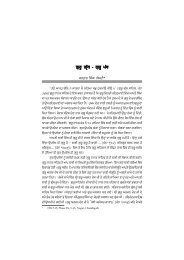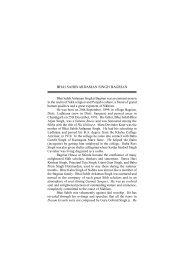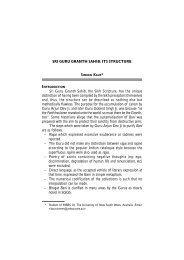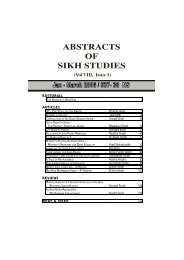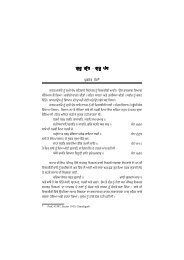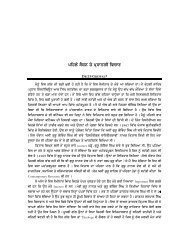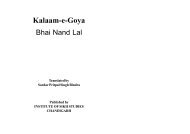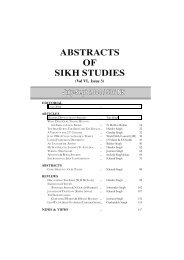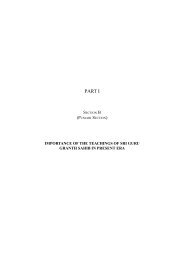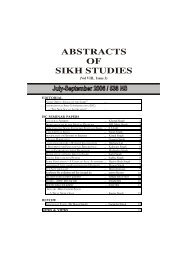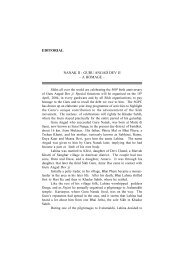editorial articles reviews news & views - Institute of Sikh Studies
editorial articles reviews news & views - Institute of Sikh Studies
editorial articles reviews news & views - Institute of Sikh Studies
Create successful ePaper yourself
Turn your PDF publications into a flip-book with our unique Google optimized e-Paper software.
86<br />
ABSTRACTS OF SIKH STUDIES : APRIL-JUNE 2005 / 537 NS<br />
in that. Nor is he interested in separating grain from the chaff, or the<br />
fact from the fiction or superstition.<br />
VII<br />
The fifth chapter “The Game <strong>of</strong> Love: The Singh Sabha and the<br />
Rhetoric <strong>of</strong> Martyrdom”, hangs around the public execution <strong>of</strong> a <strong>Sikh</strong><br />
in the first decade <strong>of</strong> 20 th century for murdering some Muslims. Such<br />
happenings were every day occurrence in that period and need not<br />
have held him. But he spends full eight <strong>of</strong> the total 60 pages over the<br />
story <strong>of</strong> one Lachman Singh, which could have involved a Muslim, a<br />
Hindu, a Christian or even a gora like Fenech himself. The fact that he<br />
does that, not only shows the non-serious character <strong>of</strong> Fenech, a<br />
fanatic, out to sensalise what should have been a serious study.<br />
Whether the Charter <strong>of</strong> Toronto University permits grant <strong>of</strong> Doctorate<br />
degree for such non-serious studies is another shameful matter to be<br />
examined, by the people <strong>of</strong> Canada itself.<br />
At the fag end <strong>of</strong> the story comes his observation that the people<br />
instead <strong>of</strong> ‘giving a “chapter on <strong>Sikh</strong>ism itself ” should instead include,<br />
“gurmat as a sub heading within the chapter devoted to Hinduism”.<br />
This shows him in real colours <strong>of</strong>, to borrow from the Chinese<br />
languages, being a running dog <strong>of</strong> Hindu chauvinism.<br />
It is surprising that people like Fenech learnt only during last two<br />
decades, i.e., 1960s or 1970s, what the convening <strong>of</strong> first Singh Sabha<br />
in 1873 meant. This only shows Fenech’s closed mind as to what really<br />
happened till even 1925, the 5th and 6th Chapter <strong>of</strong> his thesis. It<br />
seems he was either held in stupor or was only gesticulating what he<br />
read about the period. By 1879 when the main body <strong>of</strong> Singh Sabha<br />
under Pr<strong>of</strong>. Gurmukh Singh arose, Fenech quotes Oberoi to say that<br />
there were a series <strong>of</strong> such identities viz. Sahajdhari, Khalsa, Nirmala,<br />
Nirankari, Udasi, Sewapanthis, Namdhari, Dewana and many others.<br />
The main body <strong>of</strong> Tat Khalsa included Pr<strong>of</strong>. Gurmukh Singh, Giani<br />
Ditt Singh, S. Amar Singh <strong>of</strong> Bhadaur, Bhai Jawahar Singh, Giani Mayya<br />
Singh, Bhai Vir Singh, S. Wazir Singh, Bhai Mohan Singh Vaid, S. Karam<br />
Singh Historian, Mr. M.A. Macauliffe, Bhai Jodh Singh, Bhagat<br />
Lakshman Singh and Principal Teja Singh. Fenech, from Harjot Oberoi



